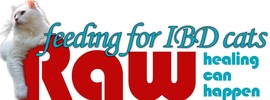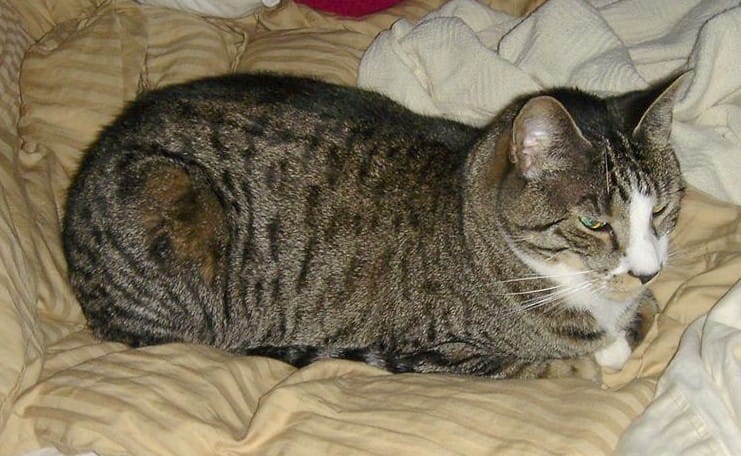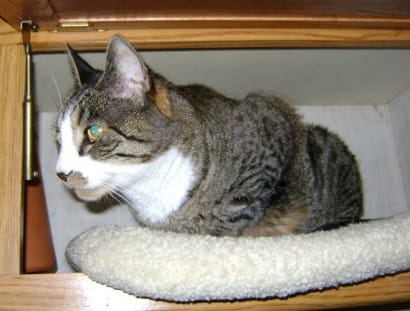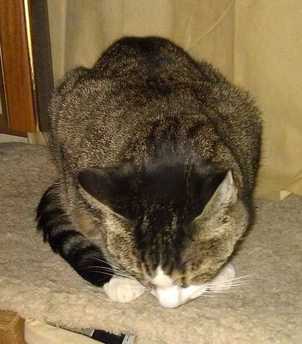Nausea in Cats - Includes Slippery Elm Bark Powder Instructions
To download and print, please click here: Nausea in Cats - Includes Slippery Elm Bark Powder Instructions
Updated 2024
Nausea & Inappetence in Cats
Nausea in cats can be difficult to identify and is often written off as a “picky” or ‘fussy” kitty. Signs / symptoms of nausea include (and they often exhibit only one of these symptoms!):
Though cats are master manipulators, and kitties that were not exposed to much in the way of different proteins or foods can be picky, what we think of as “pickiness” in a kitty’s eating habits is very often a sign that they don’t feel well. They can become very sensitive to smell, taste, texture, and temperature. ESPECIALLY if you have a kitty that isn’t normally picky, and then becomes picky, consider the problem may be nausea. It can be extremely difficult to identify and is quite insidious. There is simply no harm in treating for nausea in order to rule it out, and we suggest doing just that.
We also do not recommend giving an appetite stimulant without nausea control. How awful would that be, to feel nauseous but having your appetite stimulated?
Physical sign of nausea: the meatloaf. But not all “meatloafs” are nausea. We hope these help illustrate the difference.
Nausea & Inappetence in Cats
Nausea in cats can be difficult to identify and is often written off as a “picky” or ‘fussy” kitty. Signs / symptoms of nausea include (and they often exhibit only one of these symptoms!):
- Asking for food or appearing to be hungry, but walking away and not eating (often sniffing at the food and then walking away)
- Especially in raw fed cats, eating freeze dried treats, meat baby food or plain meat is a common symptom, easy to confuse for food boredom. Best to treat for nausea, as discussed below, before going crazy trying to identify a food or new protein kitty eats (or going back to canned!).
- Eating less than usual
- Eating slower than usual
- Needing your presence to eat
- Needing to be hand fed
- Needing encouragement to eat
- Not showing up for the meal
- Lip licking or smacking
- Drooling
- Eating/nibbling on strange things (a pica they normally don’t have)
- Hunched over water dish
- Sitting hunched up in the meatloaf position, but with the head down, eyes may be squinted
Though cats are master manipulators, and kitties that were not exposed to much in the way of different proteins or foods can be picky, what we think of as “pickiness” in a kitty’s eating habits is very often a sign that they don’t feel well. They can become very sensitive to smell, taste, texture, and temperature. ESPECIALLY if you have a kitty that isn’t normally picky, and then becomes picky, consider the problem may be nausea. It can be extremely difficult to identify and is quite insidious. There is simply no harm in treating for nausea in order to rule it out, and we suggest doing just that.
We also do not recommend giving an appetite stimulant without nausea control. How awful would that be, to feel nauseous but having your appetite stimulated?
Physical sign of nausea: the meatloaf. But not all “meatloafs” are nausea. We hope these help illustrate the difference.
|
The nauseous meatloaf. You can see Lazlo is very uncomfortable here. He was on chemo for a mass in his stomach (large cell lymphoma). The eyes closed was due to the flash, but eye squinting is a sign of pain. If they eat anything when they feel like this, they may leave some drool behind. Of course when there's drool, get teeth checked. But it can be due to nausea.
|
|
Nausea and pain. Here, Lazlo is not only nauseous, he's in pain. The head-hanging, especially when combined with eye squinting, is a kitty that is nauseous and in pain. They may be lip-smacking, lip licking, sometimes drooling. If they are hunched up like this with head over the water dish, they REALLY don't feel well.
|
Treating Nausea
There are three potent options: slippery elm bark powder (how to use it for nausea vs diarrhea is addressed here), cerenia and zofran (ondansetron). In CKD cats, acid over-production may warrant Pepcid (generic is famotidine), an acid neutralizer. For a cat with an empty tummy, you may also want to use famotidine short term. Vets seem to LOVE giving omeprazole (prilosec), but this is a PPI inhibitor: it STOPS acid production. Our cats NEED acid to digest their food, and in raw-fed cats, acid is their first and foremost defense against bacteria. If you agree to even give the PPIs, then do not feed raw.
IF YOUR CAT IS NOT EATING at all or barely eating, PLEASE hand feed or assist feed. It is imperative you get nutrition into your kitty. Cats can easily develop fatty liver disease. We don’t want to scare you, but it can cause a cascade of problems, and it can be fatal. It can also be difficult to nurse kitty back to the point of eating on their own without the assistance of tube feeding which should be employed when appropriate. Please do NOT be scared of tube feeding, it is very under-utilized in cats and is absolutely life-saving, as discussed by Dr. Lisa Pierson in her article Feeding Tubes in Cats.
On getting meds into your cat or assist feeding your cat: Medicating & Assist Feeding Your Cat
On Slippery Elm: A natural “pepto bismol” (which should never be given to cats as it contains toxic salicylates) is slippery elm bark powder. Instructions are below. Here is information on SEB by Dr. Jean Hofve:
http://www.littlebigcat.com/health/slippery-elm/
On Pepcid (Famotidine): Some kitties experience nausea due to acid over-production (most often a problem in cats with CKD), though notably, in some kitties (especially if being transitioned to raw) the problem is not enough acid, not too much – even though we’re seeing stomach acid pukes. That’s usually a meal-timing problem, discussed here. Antacids are over-used, especially in IBD cats, and what many need in the transition is actually a few drops of raw, organic apple cider vinegar in their meals to aid digestion. On the other hand, cats with chronic kidney disease (CKD) have problems with producing acid at the wrong time or the signalling to stop producing the acid at the right time, so if you have a kitty with CKD that is having acid pukes, consider trying an antacid (NOT a PPI like omeprazole. See above). Tanya’s site on Chronic Kidney Disease site has pertinent information on this: http://www.felinecrf.org/nausea_vomiting_stomach_acid.htm
If you have an IBD kitty that is vomiting, please see The Problem with Pepcid, a 3-part series that also addresses what is fed, how it is fed, and when it is fed; and has a complete review of nausea treatments in cats. If you have an IBD kitty transitioning to raw, or recently transitioned, please refer to the article on managing acid pukes: How to Manage Acid & Bile Puking
On Cerenia: A prescription anti-emetic medication, cerenia, is generally very effective in controlling nausea. Interestingly, it has been shown to have some pain killing properties, yet another reason it is so commonly employed in pancreatitis. If you suspect your kitty is nauseous and slippery elm bark powder (“SEB”) syrup does not help control it, we suggest discussing cerenia for your cat with your vet. Cerenia may be needed for its anti-emetic properties, and it remains possible nausea still needs to be controlled.
On Zofran (generic is ondansetron): this is an anti-nausea medication. If SEB or cerenia don’t manage nausea, request ondansetron. You can use it along with cerenia, or you can use it instead of cerenia. Please note, cerenia has other benefits beyond nausea / vomiting control AND it is only dosed once a day. Ondansetron is typically dosed 2x a day, but may need to be given every 8 hours given its short half-life in cats and your vet may not be familiar with this study. Ondansetron can also have the side-effect of constipation in some cats. If you have a constipation prone cat, you may want to avoid it, or be on very high alert for bowel movement patterns as constipation can cause or compound nausea.
On Appetite Stimulants: If you see improvement with the use of nausea control, but kitty is still not eating well, consider you may also need an appetite stimulant. There are two common stimulants used in cats: cyproheptadine, an anti-histamine, typically very safe and effective. It is administered 2x a day. Please note, antihistamines can make kitty groggy. The other commonly prescribed appetite stimulant is mirtazapine. This is an old-line anti-depressant in humans. It can be very effective, vets love it as dosing is typically every-other-day (some vets still use the old dosing schedule of more given every 3 days, but this is riskier, as it is more likely to cause serotonin syndrome in your cat). PLEASE do not give your cat an appetite stimulant without nausea control. There is a topical form applied to the pinna of the ear called mirataz, and many people find this very convenient.
Slippery Elm Bark Instructions (for managing nausea)
There are two methods of using slippery elm bark powder for nausea control. Mixing it directly into food is for managing diarrhea. For nausea, it should be given about half an hour before the meal.
ON THE TIMING OF ADMINISTRATION. It is mentioned in many places, particularly in Facebook groups, to separate administration of slippery elm by other medications by 2 hours. We don't know the source of this information. Dr. Hofve in her article on slippery elm mentions that "Slippery Elm may interfere with the absorption of certain minerals and pharmaceuticals, so is best given separately from any concurrent drug therapy." A popular myth is that the problem with SEB and other gelatinous fibers is that it affects absorption because it "coats" the GI tract and this somehow blocks uptake of the medications. That is not the reason for feeding it separately from meds or food. We know from research that "gelatinous fibers" can slow down movement through the GI tract, and long term this can interfere with mineral absorption. That isn't an issue with SEB, as it is rich in nutrients, including minerals. So if one is using it in quantities that would impact mineral absorption, it is already compensating for that. So why the 2-hour gap between meds and SEB? We just don't know. There isn't a warning not to give meds with foods that contain guar gum, xanthan gum, carrageenan, agar agar, acacia gum, etc. These are all gelatinous fibers. There isn't a warning not to give meds with high fiber foods. Given it takes SEB, whether mixed with George's aloe vera drink or made as a "syrup" about half an hour to go to work, whether or not to give it more time than that is up to you. If you have a holistic vet that might have an opinion on this, ask these questions. But our personal experience is that not waiting two hours has zero impact on efficacy of medications. Laurie had a CKD cat that wouldn't eat without SEB. He had high blood pressure and was proteinuric. If the SEB had an impact on medication uptake, it would be visible and quickly via a rise in blood pressure or in loss of efficacy of his meds controlling the creatinine levels in his urine. All medications remained as effective as when they were given before he needed SEB at every meal - and this was done for an entire year with blood work, blood pressure measures, and urinalysis every three months.
There is also a popular warning that slippery elm is high in calcium and can raise calcium levels in cats with kidney disease or mineral metabolism disorders. What most fail to acknowledge with this warning is two-fold:
1) long term use of gelatinous fibers can impact mineral absorption in the first place, and the minerals in SEB merely compensate for that;
2) The amounts of slippery elm bark powder we give for nausea are very small. If using it as a syrup or mixed with George's aloe vera drink the incremental calcium would be tiny, and unlikely to have an impact in relation to the amount of dietary calcium consumed daily.
We are not aware of any cats that experienced increased calcium from using slippery elm bark powder for nausea. Of course that doesn't mean they don't exist and it can't happen. So if you have a cat with elevated blood calcium or borderline high calcium and begin the use of slippery elm, it is best you retest blood work within a week or two of starting it, and if needed long term, we recommend another recheck after one month. If calcium levels rise, stop the use of SEB and use ondansetron or cerenia.
Instructions for mixing SEB with George’s Aloe Vera Drink. Many do not have access to George’s Aloe Vera Drink. Skip to Slippery Elm Bark syrup instructions, below. That said, it is the experience of those who have used both that mixing SEB with the George’s aloe is more effective. (Please note, George’s is the only one we recommend, it is distilled and has those things that are toxic to cats removed, yet retains its beneficial qualities).
To use SEB with George’s aloe vera drink, simply mix 1/8th teaspoon SEB with one-quarter teaspoon of the drink. It gets thick. I use a chopstick to mix until it forms a ball that is basically pea-sized and keeps its shape pretty well. I stick it to the back of the roof of the mouth, and then tip kitty’s head up by pushing up under the chin until the cat swallows. Several eat it mixed with tuna juice rather than forming the little ball. You can also mix the 1/8 teaspoon of SEB and 1/4 George’s aloe with water, and syringe it into your kitty.
Slippery Elm Bark “Syrup." Bring to a boil then simmer 1 teaspoon of slippery elm bark powder (“SEB”) in 1 cup of water, whisking it, for 4 - 5 minutes. It will thicken as it cools. Store it in the fridge for up to 5 days.
You can also put the 1 teaspoon of powder in a microwave safe cup, add 1 cup cold water, stir. Cook on high 30 seconds, stir. Repeat. Then cook on 50% power for 3 – 4 minutes, stirring several times along the way. It will thicken as it cools.
Give kitty 3 – 5ML or one teaspoon 45 minutes to half an hour before a meal to help settle the tummy. You can either mix with water in a small dish to thin it out and then sprinkle something on top to entice them to eat it up, freeze dried meat or liver treats are plain and often do the trick. If you need to use a syringe, the syrup works easily in one. This can be used three – four times a day. Instructions for using a syringe are here.
If you have treated for nausea, and included an appetite stimulant, and kitty still refuses food, of course get to a vet. But if when you are confident - or pretty sure you're dealing with boredom - please refer to My Cat Stopped Eating Raw, What Do I Do?





